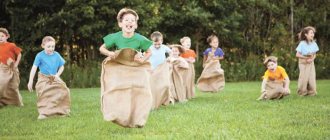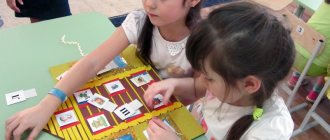MAGAZINE Preschooler.RF
Games - dramatization in the communicative development of younger preschoolers based on the perception of artistic words and integrationVorobyova Margarita Evgenievna Educator, MDOU “Kindergarten of general developmental type No. 29, village. Red October"
Currently, the problems of speech development of preschool children have become more relevant and significant. Coherent speech performs the most important social functions: it helps the child establish communicative connections with people around him, determines and regulates the norm of behavior in society, expands the scope of his social orientation, which is a decisive condition for the development of his personality. This means that the development of the child’s personality also depends on the development of speech.
This begs the question: How can theatrical activities affect not only the development of communication abilities, but also the development of a child’s personality? Working with young children, we noted that the problem of communicative development is also relevant for us.
We settled on dramatization games. A game is a means of learning and the main activity of a preschool child, so it can be used when mastering any program material. Dramatization games are special games in which the child acts out a familiar plot, develops it, or comes up with a new one. In the game, a child turns into an actor, a director, and a screenwriter. A child never plays such games in silence. Using his own voice or the voice of a character, the child pronounces events and experiences. He voices the characters, comes up with a story, experiences things that are not easy for him to live through in ordinary life. During such games, intensive development of speech occurs, vocabulary is enriched qualitatively and quantitatively, the child’s imagination, creative abilities, and ability to control himself develop. Dramatization games contain great opportunities for simultaneous solution of problems of social-communicative, cognitive-speech, artistic and aesthetic development of preschool children, which integrates the knowledge and skills of children and creates conditions for their creative development and application.
Works of literature contribute to the development of speech and provide examples of the Russian literary language. From the book, the child learns many new words and figurative expressions, and his speech is enriched with emotional vocabulary. Therefore, the purpose of many teaching techniques is to make it easier for children to listen and understand. The objectives and content of introducing children to fiction in preschool settings are presented in the general education programs of kindergartens.
Thus, folk tales, songs, nursery rhymes, and riddles provide examples of rhythmic speech and introduce children to the colorfulness and imagery of their native language. This includes simple content, familiar characters that evoke a feeling of sympathy, and a simple, accessible form of presentation. In them, as we know, good and evil are distinguished, and clear assessments are given of the actions of the heroes. Positive and negative characters are identified. Taking all this into account to develop the expressiveness of children's speech, works of oral folk art (which includes a regional component, folk games, toys and dramatization games) will provide us with invaluable assistance in the development of children's communicative abilities. A child’s perception of a work of art is a special form of meaningful activity.
Goals and objectives that need to be solved by the teacher leading the process of dramatization games: providing children with assistance in acquiring gaming skills, enriching their gaming experience; developing interest and love for the book, the ability to listen and understand it; helping the child in discovering the world of verbal art, in conveying the expressiveness of the intonations of folklore and simple texts; expansion of children's ideas about objects, events and phenomena of the surrounding world, which can then be reflected in the game; encouraging children's initiative when developing individual, paired and collective dramatization games.
To implement these tasks, the following conditions are necessary: material resources and development environment; the presence of theaters: finger, table, shadow, puppet, etc.; screens, decorations; audio recordings of fairy tales, songs, nursery rhymes; sets of illustrations for fairy tales; the presence of fiction (books with nursery rhymes, fairy tales, scripts, etc.); “Ryazhenya” corner in a group for children to independently implement different roles and ideas; costume room
This type of activity is labor-intensive because it requires time spent on preparing costumes and theater fairy tales to show to children, the necessary attributes, scenery, and setting up the scene. A lot of time is spent on developing children’s interest in books, learning individual passages and dialogues, gradually replenishing their literary baggage, the need to look at illustrative books, enriching literary experience and, finally, developing skills in the ability to take on different roles, both independently and jointly. activities. Dramatization game is an integrated type of children's games based on literary material. Acting as one of the forms of plot-role-playing game, the dramatization game based on a fairy tale has its own characteristics: it represents a synthesis of the perception of the work and role-playing game.
The process of assimilation and perception includes 3 stages.
- stage The management of dramatization games is based on work: 1) - on the text of a literary work. As preliminary work, we first use reading the work on which we are going to conduct a dramatization game, examining and verbally describing pictures and toys based on the fairy tale; 2) — in communication classes we use a creative approach to working with a book: a conversation on the content of a fairy tale, alternating choral and individual responses, emotional and playful techniques, holding literary and art exhibitions; 3) — we teach children a coherent, sequential retelling of the text. Retelling makes it possible to improve conversational speech, in particular intonation, address and enumeration. Thus, taking into account the individual characteristics of children, we create together with them a situation of joint play creativity, without forcing anyone in any way. But some children have weak play initiative, and perhaps an undeveloped imagination; the teacher’s task is to help create images of characters and, of course, begin play actions themselves.
- figurative-role stage. The child begins to try on the “clothes” of various characters. Inanimate objects become animated, animals think and feel like humans. The period of figurative role-playing begins, that is, children move from verbal speech to acting out a familiar fairy tale. When preparing for the game, we use different methods, for example, personal example in playing out the role of the characters, or older children portray one of the characters from the fairy tale without words, and the younger ones guess, because in the conditions of the game on the theme of the fairy tale, it is easier for the child to enter the role and create an image. When developing children's artistic speech abilities through the dramatization of fairy tales, it is important to teach them to imitate the actions of the characters, for example: to show how a clumsy bear walks, a fox wags its tail, a bunny jumps, how he is afraid of being hit by a fox. We use means of expressiveness (intonation, facial expressions, staging, the bear speaks in a rough, thick voice, the fox speaks affectionately, the hare speaks quietly, etc.). In the game, we encourage independent statements regarding the plot of the fairy tale, the actions of peers, and our own experiences. Dramatization of a fairy tale usually takes place in the evening; in a joint activity we act out familiar fairy tales, nursery rhymes, and dramatizations with the children. Children enjoy dressing up in costumes and playing roles. Then, in an independent game, they themselves organize dialogic communication on behalf of fairy-tale characters.
- stage of development of children's play - role-playing game. As a result of our activities in the first two stages, we saw results. Children learned on their own not only to dramatize the plots of small familiar literary works, but also to simply communicate by role, using play material that is located in an accessible place (matryoshka dolls, puzzles, puppet theater, rubber toys, lacing, etc.). Play activities occur both independently and in collaboration with the teacher.
What does integration within the framework of a dramatization game imply in communication classes? Theatrical play is initially synthetic in nature: it is a literary text and a spoken word, a display of movements accompanied by music, drawing of individual characters, a theater show, which allows solving problems of a cognitive, social, aesthetic and speech nature. After all the stages have been completed, all we have to do is include dramatization games in integrated classes. Children are happy to participate in such activities. Thus, a puppet show, a conversation game, a performance with different types of theater, audio fairy tales, a dramatization game - all this helps children to perceive the content of a fairy tale more clearly and correctly. They become both participants and spectators. Here, cooperation with parents is very important. It is necessary to talk about the child’s successes and his theatrical abilities as often as possible. Involve parents in making scenery and costumes, participating in matinees and entertainment, inviting them to meetings and round tables. The closer this cooperation is, the more parents learn about their children, the characteristics of their character, temperament, dreams and desires.
The phased nature of the work ensured that children gradually became closer to the characters of the works. Children became more interested in books, more often began asking to read this or that fairy tale, and looked at illustrations in books with interest. Getting closer to the characters, turning them into friends or foes well known to children, role-playing, through creating environmental conditions and helping children acquire gaming skills, these are the ways that helped us get a positive result
In the process of preparing for the game activity and implementing its plan, we came to the following conclusions: the dramatization game helps the development of creativity, personality, activity, emotional responsiveness, deep immersion in the content and images of the main characters of fairy tales, has a positive effect on the result of enriching children with new skills and skills, living the images of heroes, the ability to coherently and correctly express one’s thoughts, use speech, using expressive means. The special atmosphere, emotional response and lively reaction of children during integrated classes showed the real power of dramatization games in children’s perception of the artistic word and increasing the effectiveness of work on the communicative development of children of primary preschool age and the formation of a holistic picture of the world in children.
| Next > |






